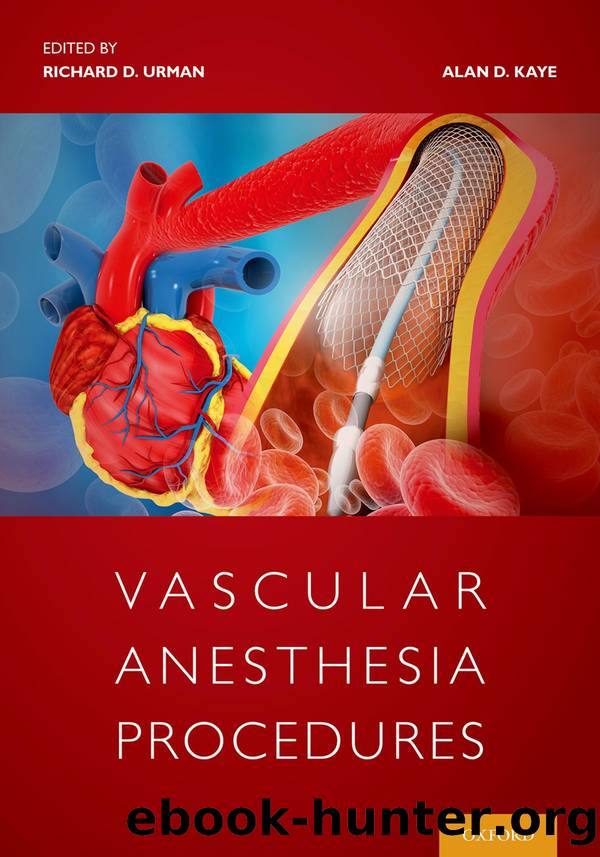Vascular Anesthesia Procedures by Richard Urman;Alan Kaye;

Author:Richard Urman;Alan Kaye;
Language: eng
Format: epub
Publisher: OUP Premium
Published: 2021-10-15T00:00:00+00:00
b. Surgical factors
i. Understand the surgical plan with extent of coverage and perfusion to the branch vessels
ii. Consider risk-reducing strategies such as neuromonitoring, lumbar drain for spinal cord protection, blood pressure goals to mitigate organ perfusion and risks for aortic rupture, and more
2. Intraoperative care
a. General anesthesia with oral endotracheal tube is preferred.
b. Monitoring
i. ASA stand monitor, continuous right radial arterial pressure, central venous pressure (CVP), urine output
ii. Neuromonitoring: SSEP, motor evoked potential, NIRS monitors placed over the cervical spine and lower thoracic spine to detect SCI
iii. Lumbar cerebrospinal fluid (CSF) drain: Indications for a lumbar drain are anticipated endograft coverage of T9âT12, thoracic aortic coverage of greater than 20 cm, compromised collateral pathways, or symptomatic SCI in a patient who did not have a drain placed preoperatively.
iv. Transesophageal echocardiography (TEE): An important adjunct to fluoroscopy. It evaluates aortic pathology and cardiac function, identifies true and false lumen in the case of aortic dissections, guides the guidewire placement, confirms proper deployment of the endograft, and evaluates endoleaks. It potentially decreases contrast usage.
Download
This site does not store any files on its server. We only index and link to content provided by other sites. Please contact the content providers to delete copyright contents if any and email us, we'll remove relevant links or contents immediately.
| Administration & Medicine Economics | Allied Health Professions |
| Basic Sciences | Dentistry |
| History | Medical Informatics |
| Medicine | Nursing |
| Pharmacology | Psychology |
| Research | Veterinary Medicine |
When Breath Becomes Air by Paul Kalanithi(7264)
Why We Sleep: Unlocking the Power of Sleep and Dreams by Matthew Walker(5642)
Paper Towns by Green John(4169)
The Immortal Life of Henrietta Lacks by Rebecca Skloot(3826)
The Sports Rules Book by Human Kinetics(3588)
Dynamic Alignment Through Imagery by Eric Franklin(3489)
ACSM's Complete Guide to Fitness & Health by ACSM(3469)
Kaplan MCAT Organic Chemistry Review: Created for MCAT 2015 (Kaplan Test Prep) by Kaplan(3423)
Introduction to Kinesiology by Shirl J. Hoffman(3301)
Livewired by David Eagleman(3123)
The River of Consciousness by Oliver Sacks(2992)
Alchemy and Alchemists by C. J. S. Thompson(2912)
The Death of the Heart by Elizabeth Bowen(2901)
Descartes' Error by Antonio Damasio(2732)
Bad Pharma by Ben Goldacre(2730)
Kaplan MCAT Behavioral Sciences Review: Created for MCAT 2015 (Kaplan Test Prep) by Kaplan(2492)
The Gene: An Intimate History by Siddhartha Mukherjee(2491)
The Fate of Rome: Climate, Disease, and the End of an Empire (The Princeton History of the Ancient World) by Kyle Harper(2436)
The Emperor of All Maladies: A Biography of Cancer by Siddhartha Mukherjee(2431)
